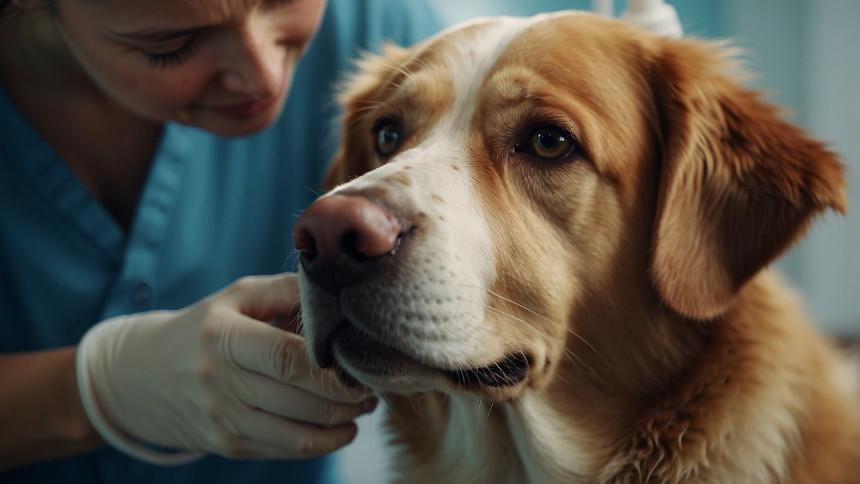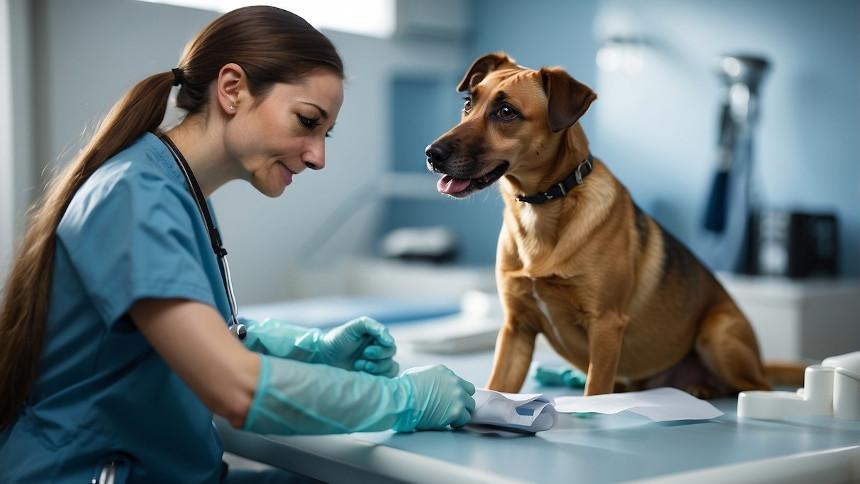Abscesses in dogs present a common yet potentially serious skin condition that warrants attention from both pet owners and veterinarians. Characterized primarily by localized collections of pus, these abscesses appear as swollen, often painful areas on a dog’s body. They may occur under the skin, at the root of a tooth, within the anal glands, or even on the paws. The formation of these pus-filled areas is typically the result of a bacterial infection, which can enter the body through wounds or injuries.
Treatment for skin abscesses in dogs usually requires professional care. If left untreated, the infection can spread, leading to more severe health issues. Signs of an abscess may include severe inflammation, excessive licking or chewing at the site, loss of appetite, weakness, reluctance to move, and fever. It is important for dog owners to recognize the symptoms early and seek veterinary assistance to address the infection and prevent complications.
Understanding Dog Abscesses
An abscess in dogs is essentially a collection of pus that has built up within the tissue of the body. When it comes to the skin, skin abscesses are a rather common ailment. Bacteria is the main culprit behind these painful swellings, gaining entry through wounds or as a result of a foreign object piercing the skin.
Once bacteria infiltrate the skin, an immune response ensues, leading to the accumulation of white blood cells and, consequently, pus. This process triggers inflammation, leading to the characteristic swelling and tenderness of an abscess. The affected area may manifest various symptoms:
- Swelling
- Redness
- Warmth
- Pain or discomfort
Dog abscesses may vary in size and can flare up anywhere on the dog’s body, such as under the skin, near tooth roots, or in anal glands. However, the skin is the most common site for these infections. If an abscess ruptures, it will release pus, which can be alarming for a pet owner but may actually reduce the pain as pressure is relieved.
Prompt medical attention is crucial in treating an abscess. If left untreated, the infection can spread, leading to more serious health issues. Treatment typically includes:
- Cleaning the affected area
- Draining the abscess
- Antibiotics to fight the infection
- Pain management if necessary
Dog owners should monitor their pets for signs of infection and seek veterinary care if an abscess is suspected. Early intervention can prevent complications and ensure the animal’s quick recovery.
Causes of Skin Abscess in Dogs
Skin abscesses in dogs are typically a result of bacterial infiltration following various types of skin breaches. It’s essential to understand the common causes leading to these painful infections.
Bite and Scratch Injuries
Bite and scratch injuries are among the primary causes of skin abscesses in dogs. When another animal bites or scratches a dog, bacteria from the aggressor’s mouth or claws can be introduced into the skin. This is a common issue, especially in dogs that roam outdoors or are in environments with other animals.
- Bites: Can transfer bacteria directly into the tissue.
- Scratches: May create surface abrasions that become infected.
Penetrating Wounds
Penetrating wounds, such as those caused by stepping on sharp objects or accidental impalement, often lead to abscesses. These wounds allow bacteria to bypass the outer defensive layers of skin and introduce infection into deeper tissues.
- Foreign objects: Objects like thorns or shards of glass can become embedded.
- Deep lacerations: Wounds that extend through multiple layers of tissue.
Anal Gland Complications
Complications with anal glands can also result in abscess formation. Anal glands, or anal sacs, typically empty when the dog defecates. However, if they become clogged, infected, or impacted, an abscess can form.
- Impacted anal glands: May lead to an infection and subsequent abscess.
- Anal gland infection: A bacterial infection in the gland can lead to pus formation.
Dental Issues
Dental problems, particularly tooth root abscesses, are another significant cause of skin abscesses in dogs. If a dog’s tooth becomes infected, the abscess can penetrate the surrounding bone and extend into nearby skin.
- Tooth decay or injury: Can lead to infection at the tooth’s root.
- Tooth root abscess: If bacteria invade the root, the infection can spread to surrounding tissues.
Symptoms of Abscesses in Dogs
Abscesses in dogs can present a variety of symptoms depending on their location and severity. Commonly observed signs include:
- Swelling: A prominent lump can often be seen or felt on the dog’s body.
- Pain: The abscessed area may be sensitive to touch, causing the dog discomfort.
- Fever: Dogs with abscesses can exhibit a fever due to the infection.
- Redness and Inflammation: The skin surrounding the abscess may become red and inflamed.
Dogs may also show behavioral changes and related symptoms such as:
- Licking or Chewing: Overly focused attention on the area, such as licking or chewing, can indicate an abscess.
- Hair Loss: In the area of the abscess, hair loss may occur.
- Reduced Mobility: Dogs might move less if the abscess is affecting their comfort.
A physical examination often reveals:
- Pocket of Pus: An abscess is a collection of pus that has built up within the tissue of the body, forming a noticeable pocket.
- General Discomfort: Dogs may whimper or show resistance to being touched due to the tenderness of the area.
In summary, spotting the symptoms of an abscess in dogs involves observing changes in the skin’s appearance, monitoring the dog’s behavior for signs of discomfort, and being aware of systemic signs of infection such as fever. Early detection can lead to prompt veterinary care, which is essential in preventing more serious complications.
Diagnosing Abscesses in Dogs
When a dog exhibits signs of a skin abscess, such as painful swelling or a noticeable lump, it is important for a veterinarian to assess the condition. The diagnostic process involves a physical examination where the veterinarian will carefully evaluate the affected area. They look for signs of pain, the size of the swelling, and any discharge that may indicate the presence of pus.
Symptoms that may lead a veterinarian to suspect an abscess include:
- Warmth and redness at the site
- Pain or discomfort when touched
- A noticeable lump beneath the skin surface
- Lethargy or changes in behavior due to discomfort
If an abscess is found during the examination, the next step may involve collecting a sample of the pus. This is sent for a bacterial culture and culture and sensitivity test. Such tests are integral to identify:
- The type of bacteria causing the infection
- The most effective antibiotics for treatment
Skin abscesses in dogs can vary in severity and sometimes may resemble other conditions. Therefore, accurate diagnosis is vital for effective treatment. Depending on the location and severity, imaging like ultrasound or X-rays may be utilized to understand the abscess’s impact on deeper tissue.
It is critical for pet owners to seek veterinary advice when an abscess is suspected. Prompt and effective diagnosis can lead to a quicker resolution of the infection and reduce the risk of complications.
Treatment Options for Dog Abscesses
Effective management of dog skin abscesses requires both professional veterinary care and follow-up home treatments. From medical interventions to surgical procedures, each treatment is aimed at combating infection and promoting healing.
Medical Treatments
For a non-complicated abscess, veterinarians often prescribe antibiotic therapy to fight the underlying bacterial infection. Wound care with antibiotic ointment and proper bandaging are also common. If the abscess has not yet ruptured, warm compresses applied to the site may encourage drainage and provide pain relief. In some cases, the vet may initiate treatment with pain medication to ensure the dog remains comfortable.
Surgical Interventions
If an abscess is large, or does not respond to medical treatment, surgery may be necessary. Surgically opening the abscess allows for direct drainage of pus, a critical step in the healing process. Post-surgical care typically includes antibiotics and pain relief medication. For abscesses related to anal sacs, the vet may need to flush the anal sac ducts to aid in recovery.
Home Care and Aftercare
Once the abscess is treated, either medically or surgically, home care becomes crucial for recovery. Cleansing the area with warm water, applying prescribed antibiotic ointments, and changing bandages are typically advised. Regular monitoring of the wound for signs of infection or complications is essential. Additionally, administering any prescribed antibiotics or pain medications as directed is necessary to prevent recurrence and ensure complete healing.
Complications and Prognosis
Complications
When treating skin abscesses in dogs, it is crucial to be aware of potential complications, which can arise if the abscess is not properly or timely addressed. Complications may include:
- Spread of Infection: The infection can spread to other parts of the body, including vital organs, potentially leading to life-threatening conditions.
- Systemic Infection: The presence of bacteria can trigger a widespread inflammatory response, where white blood cells rush to combat the infection, sometimes resulting in sepsis.
- Delayed Healing: If an abscess is not properly drained or is recurrent, it can impede the recovery process, prolonging discomfort and increasing the risk of further complications.
Prognosis
The prognosis for a dog with a skin abscess generally is positive, given prompt and appropriate treatment. The key factors influencing recovery include:
- Early Intervention: Timely veterinary care can prevent complications and result in quicker healing.
- Risk Factors Mitigation: Identifying and managing risk factors, such as underlying health conditions or environmental hazards, is critical for preventing recurrence.
- Follow-Up Care: Adherence to prescribed antibiotics and proper wound management are essential.
While the prognosis is generally good, owners should monitor their pets for signs of worsening condition and seek veterinary care if needed. It is important for the owner to ensure their dog rests and receives the full course of any prescribed medication to aid in a full recovery.
Preventive Measures and Ongoing Care
Preventing skin abscesses in dogs involves a combination of proper dental care, hygiene, grooming, and regular veterinary check-ups. By addressing these key areas, dog owners can significantly reduce the chances of abscess development and ensure the ongoing health of their pet.
Dental Care for Dogs
Robust dental hygiene can prevent the formation of abscesses around a dog’s tooth roots. Owners should regularly brush their dog’s teeth with toothpaste formulated for canines and consider dental treats and toys that help reduce plaque and tartar build-up. Scheduling annual dental check-ups with a veterinarian will catch any early signs of dental issues before they lead to abscesses.
Hygiene and Grooming
Keeping a dog’s skin and coat clean is critical to preventing skin infections that can lead to abscesses. Regular bathing and grooming should be conducted, with attention to any cuts or wounds. Excessive licking, a common sign of skin discomfort, should be monitored, as it may indicate the presence of an injury that could become infected. After any wound is noted, it should be cleaned immediately and protected from further irritation.
Regular Veterinary Check-Ups
Routine veterinary attention is vital for early detection and prevention of abscesses. A vet can provide vaccines, flea and tick preventatives, and other health services that maintain a dog’s overall well-being. Spaying or neutering your dog can also prevent certain types of abscesses. If an owner notices any signs of swelling, pain, or pus, they should seek immediate veterinary care to prevent further complications.
Understanding the Risks of Antibiotics
When treating skin abscesses in dogs with antibiotics, veterinarians consider several factors to minimize risks. Antibiotics are crucial in fighting bacterial infections, but they may have adverse effects that pet owners should be aware of.
Allergic Reactions: Dogs, like humans, can have allergies to certain medications. For instance, if a dog is allergic to penicillin, antibiotics such as amoxicillin should be avoided to prevent reactions ranging from skin irritation to more serious conditions like anaphylaxis.
Gastrointestinal Upset: A common side effect of antibiotic therapy is an upset stomach. Symptoms might include vomiting, diarrhea, and loss of appetite which should be monitored closely.
Potential for Resistance: Inappropriate use of antibiotics can lead to resistant bacterial strains. To combat this, the course of antibiotics must be followed as prescribed, without discontinuation even if symptoms improve.
Interactions with Other Medications: Antibiotics can interact with other medications the dog may be taking, potentially diminishing the effectiveness of one or more of the drugs.
Here’s a simple breakdown of potential risks:
| Risk Factor | Description | Monitoring Approach |
|---|---|---|
| Allergic Reactions | Hypersensitivity to antibiotic compounds | Observe for skin irritation, swelling, distress |
| Gastrointestinal Upset | Digestive disturbance due to antibiotic therapy | Watch for vomiting, diarrhea, lack of appetite |
| Resistance Development | Overuse can lead to less effective antibiotics | Follow full course, avoid unnecessary antibiotics |
| Medicinal Interactions | Conflicting reactions with other medications | Coordinate with vet regarding all medications |
By understanding and recognizing the risks involved with antibiotic use, veterinarians and pet owners can ensure that dogs receive the safest and most effective treatment for skin abscesses.








